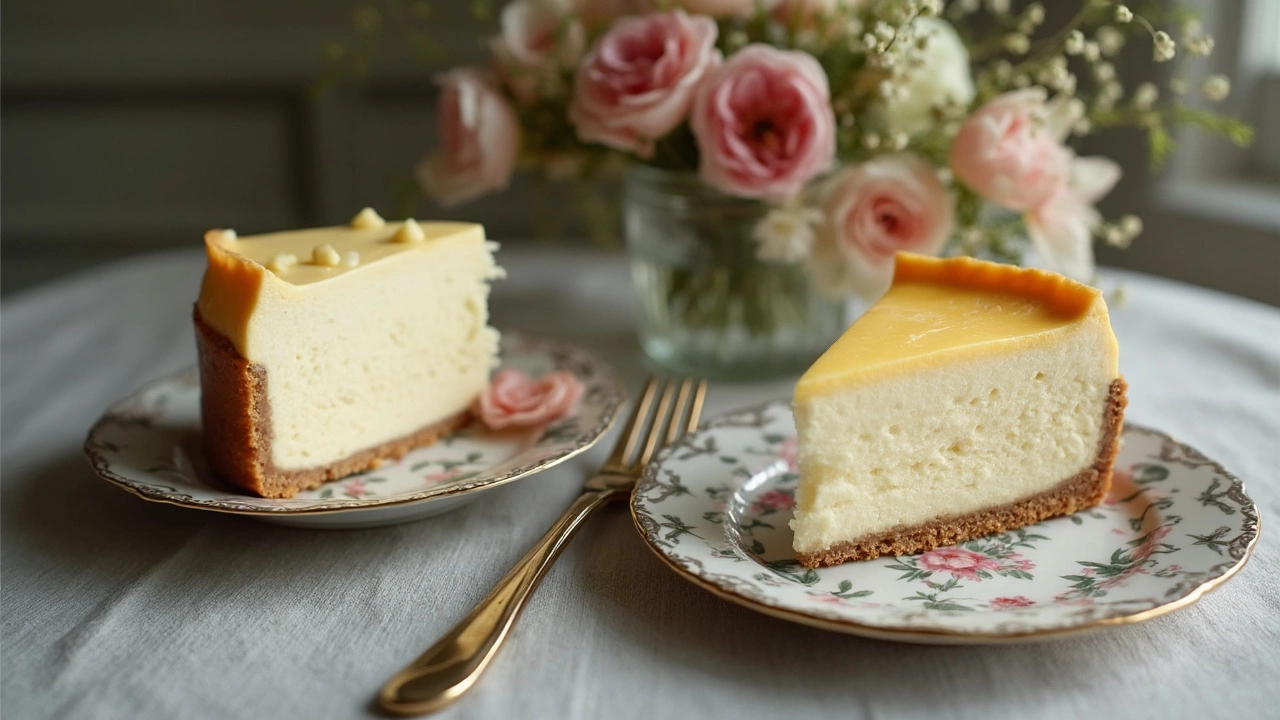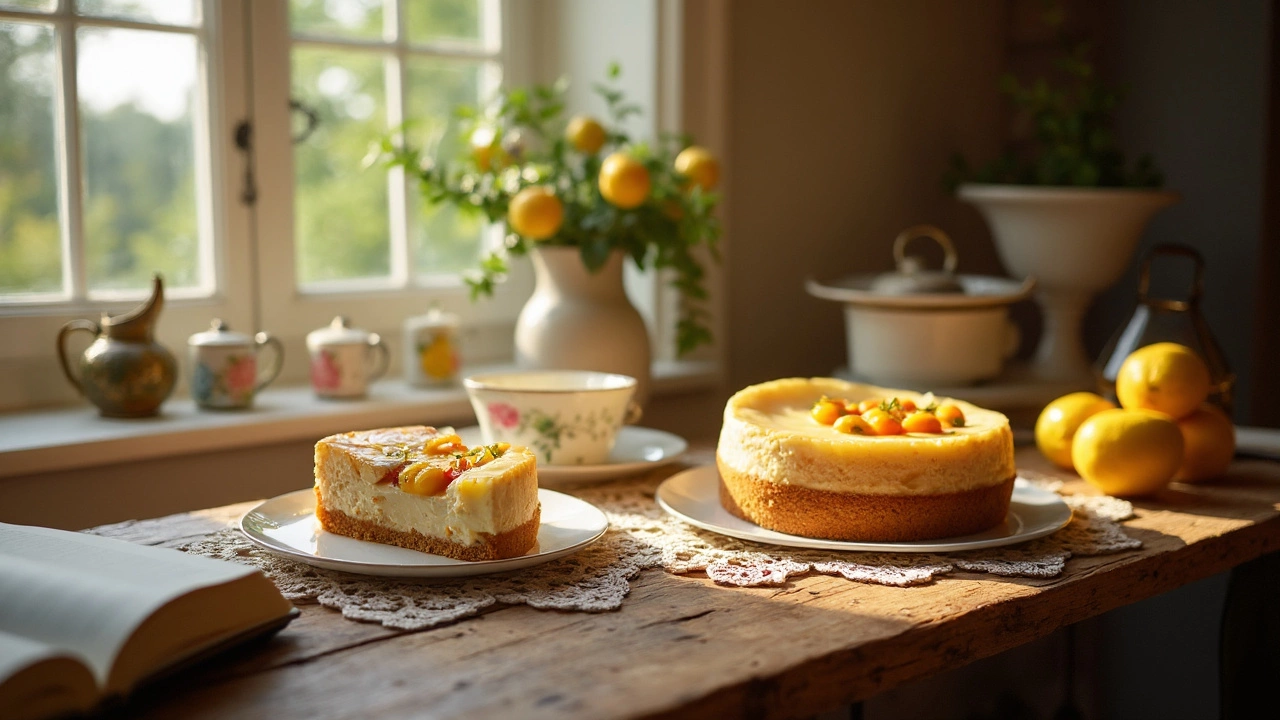Ever sliced into a cheesecake and instantly known if it's New York style or Sicilian? Most folks might not spot the difference at first bite. But if you care about flavor and love baking, these differences matter a lot. For starters, Sicilian cheesecake leans on ricotta cheese—think smooth, slightly grainy, and never overly sweet. New York cheesecake? It's famous for going all in on cream cheese, making it creamy, dense, and even a bit tangy.
This isn't just a matter of taste; ingredients shape everything. Ever notice that Sicilian versions often have a hint of citrus or cinnamon? That’s not by accident. Those flavors connect to Sicily’s food traditions and sunny groves. In New York, though, you usually get a straight-up rich flavor, sometimes with sour cream for an extra punch.
- Sicilian Cheesecake: Ingredients and History
- New York Cheesecake: What Makes It Iconic
- Texture and Taste: How Each Version Surprises You
- Classic Preparation Tricks: What’s Unique in Each Style
- Serving Traditions and Toppings
- Tips for Baking Both at Home
Sicilian Cheesecake: Ingredients and History
If you’ve ever tasted Sicilian cheesecake, you know right away it’s got a unique vibe. This isn’t your heavy New York slice. Traditional Sicilian cheesecake centers on ricotta, not cream cheese, giving it a light, slightly grainy texture and a mellow flavor. Fresh ricotta is the default choice all over Sicily. Locals say the fresher, the better, and it’s hard to argue when you taste the result.
Classic Sicilian cheesecake recipes, like those for “Cassata al Forno,” bring in key flavors like candied citrus peels, cinnamon, and sometimes even a hint of chocolate. The crust is also a twist: instead of a graham cracker base, you usually get a layer of simple pastry dough—short and crumbly, kind of like a sweet pie crust. That touch makes the cake taste homier and more old-school.
Sicilian cheesecake’s story is old—think centuries, not decades. Sicily’s famous ricotta comes from sheep’s milk and gets used in everything sweet and savory, thanks to the island’s ancient Greek and Arab influences. These trading roots brought citrus, spice, and new baking methods. By the Middle Ages, recipes for ricotta-based cakes popped up in Sicilian monasteries and towns across the island.
- Ricotta (ideally sheep’s milk)
- Sugar
- Eggs
- Candied citrus or lemon zest
- Cinnamon
- Shortcrust pastry dough
A bakery in Palermo or Catania will show off dozens of versions, but the basics never change much. Sometimes folks add a bit of chocolate or swap in orange zest for lemon, but the spirit stays the same: mild, gently sweet, and never too rich.
Fun fact—about 70% of ricotta desserts in Sicily use local citrus. That’s why you almost always catch that bright flavor. If you want to bake Sicilian cheesecake at home, don’t skimp on the zest or good-quality ricotta. Those two things are what really set it apart from the denser cheesecakes you find elsewhere.
New York Cheesecake: What Makes It Iconic
If you ask people outside of Italy to picture a cheesecake, most imagine the New York version. Classic New York cheesecake stands out for its rich creaminess, tangy bite, and sky-high slices. The star ingredient is always full-fat cream cheese. You’ll spot a thick layer, a dense texture, and a buttery graham cracker crust that crumbles just enough.
It isn’t just the cream cheese that defines this cake. Almost every classic recipe calls for a generous scoop of sour cream. Some versions add heavy cream, making the cake extra lush. Eggs help give it body, while a splash of vanilla brings all the flavors together. Sugar isn’t shy in New York style—this slice is sweet, but not overpowering. Some bakers add a dash of lemon juice for a light zing.
A cool thing about the New York cheesecake is the baking method: it usually gets baked low and slow in a water bath. This technique helps avoid ugly cracks, giving you that smooth top everyone wants. The cake also chills overnight, which sets the texture just right. Try cutting in early and you’ll get a mess on your plate—the wait matters.
Here’s a quick breakdown of typical ingredients by weight for a standard 9-inch New York cheesecake:
| Ingredient | Average Amount (grams) |
|---|---|
| Cream cheese | 900 |
| Granulated sugar | 200 |
| Eggs | 200 |
| Sour cream | 240 |
| Heavy cream | 120 |
| Graham cracker crumbs | 150 |
| Butter (for crust) | 80 |
This style of cheesecake became a New York staple back in the early 1900s. Jewish delis and diners helped spread the trend. The main reason it got so popular? Philadelphia cream cheese was mass produced starting in the late 1800s and made great cakes easy to bake. Today, nearly every American bakery has its own New York cheesecake, but the mighty classic—with a tall, creamy filling and simple graham crust—still wins a ton of fans.
Texture and Taste: How Each Version Surprises You
If you put a slice of Sicilian cheesecake and a slice of New York cheesecake side by side, you’ll notice they feel and taste worlds apart. Let’s break it down: Sicilian cheesecake has a more rustic crumb. That’s thanks to using ricotta, which never gets completely smooth, even with a food processor. The taste is usually lighter, with hints of citrus or cinnamon sneaking in. It doesn’t feel heavy in your mouth and there’s often a gentle sweetness instead of that deep, sugar-heavy punch.
With New York cheesecake, it’s all about that ultra-smooth, dense texture. Cream cheese is the star here, blending until every bite is creamy—almost like eating cheesecake fudge. The flavor stands out with tang from the cream cheese and sometimes that slight sharp note from a bit of sour cream. You mostly taste pure richness, sometimes with vanilla or just the signature cream cheese profile. People who love New York cheesecake often say a small piece fills you up fast.
Here’s a quick side-by-side of what to expect with each:
| Cheesecake Type | Texture | Taste |
|---|---|---|
| Sicilian | Light, grainy, almost fluffy | Slightly sweet, citrusy, sometimes spiced |
| New York | Dense, smooth, creamy | Rich, tangy, deeply sweet |
If you’re baking at home, remember: the choice of cheese handles most of the heavy lifting for texture. Ricotta never blends out fully smooth, but cream cheese always aims for that melt-in-your-mouth vibe. That’s the main reason why each version is a surprise—your spoon expects the usual, and then you get that totally different bite.

Classic Preparation Tricks: What’s Unique in Each Style
Let’s get into what really makes a Sicilian cheesecake different from a New York cheesecake when you’re actually in the kitchen. These aren’t just minor swaps—how you prepare each one totally changes the final taste and texture!
Starting with Sicilian cheesecake, it’s all about ricotta. You need to drain the ricotta well, usually overnight, to keep things from getting soggy. Most recipes skip a crust altogether or go for a super simple cookie or sponge base. Here’s something quirky: Sicilian versions often add orange zest, citron, or even little bits of chocolate. Many folks use a quick whisk or even just a fork to mix—no heavy mixer required. It keeps the cake rustic and light. Baking is low and slow, more like a custard than a tall American cheesecake, and you definitely don’t want a burnt top. A water bath isn’t required with this style since you want it set, not ultra creamy.
The New York cheesecake is a different story. Think dense, creamy, and tall—that’s what you’re aiming for. First, you usually make a base out of crushed graham crackers with plenty of butter. Then, you haul out the cream cheese, mix it with sugar, eggs, sometimes a hit of sour cream, plus a splash of vanilla. Here, you want everything ultra smooth—most bakers use a stand mixer to get it satiny and lump-free. Don’t skip the water bath; it keeps the cake from cracking and locks in that signature creamy texture. New Yorkers bake it at a high temp to start, then drop the heat, letting it finish gently. This trick gives you a cake that’s firm yet creamy, never rubbery.
Here’s a quick rundown that pinpoints the biggest differences:
- Ricotta vs. Cream Cheese: Sicilian uses ricotta, New York uses only cream cheese.
- Mixing Methods: Sicilian is rustic (hand-mixed), New York is silky smooth (machine-mixed).
- Baking Technique: No water bath for Sicilian; essential for New York.
- Crust: Optional and minimal in Sicilian, thick graham crust in New York.
- Flavors: Sicilian can pack in citrus or candied fruit, New York keeps it classic and plain.
And if you’re wondering how much this affects baking time, check this handy comparison:
| Style | Typical Bake Time | Oven Temp |
|---|---|---|
| Sicilian | 50-60 minutes | 325°F (165°C) |
| New York | 80-90 minutes | Start at 450°F (230°C), then reduce to 225°F (110°C) |
So, if you ever tackle one of these cheesecakes at home, pay close attention to these little tricks—they make all the difference between a slice that’s meh and one that’s pure magic.
Serving Traditions and Toppings
How you serve Sicilian cheesecake and New York cheesecake tells a story about their origins and local flavor. In Sicily, cheesecake—also called cassata al forno—shows up around Easter and big family celebrations. It often gets dusted with powdered sugar or scattered with candied citrus peels, reflecting Sicily’s famous lemons and oranges. Cinnamon occasionally sneaks in, either in the filling or sprinkled on top, for that extra warmth. Don’t expect a heavy fruit sauce or chocolate drizzle—Sicilian cheesecake likes to keep things simple and let the ricotta shine.
Serving New York cheesecake is all about indulgence and options. Classic New York diners serve it plain or with a shiny layer of strawberry glaze. Some add a mountain of fresh berries, while others prefer rich chocolate or caramel sauces drizzled right before serving. In popular bakeries, you might spot slices with whipped cream, cookie crumbs, or even crushed nuts. Variety is huge in the New York world—it’s rare to see just one topping on display.
The temperature matters, too. Sicilian cheesecake is usually served at cool room temperature or slightly chilled, which brings out that ricotta flavor. New York cheesecake is served straight from the fridge, extra cold to stay dense and firm.
- Sicilian cheesecake: Room temp or barely chilled, powdered sugar, citrus peels, sometimes a dusting of cinnamon.
- New York cheesecake: Cold from the fridge, fruit sauces, whipped cream, chocolate or caramel drizzle, nuts, even cookie crusts on special occasions.
Here’s a quick comparison of typical toppings and serving temps:
| Cheesecake Style | Common Toppings | Traditional Serving Temp |
|---|---|---|
| Sicilian | Powdered sugar, candied citrus, cinnamon | Room temp or lightly chilled |
| New York | Fruit sauces, whipped cream, chocolate, nuts | Cold |
So next time you spot a cheesecake at a party or on a menu, check out the toppings and how it's served. They usually give away whether you’re about to eat the simple charm of Sicily or the bold, creamy richness of New York.
Tips for Baking Both at Home
Baking a Sicilian cheesecake or a New York cheesecake at home comes down to understanding the right technique for each style. The ingredients matter just as much as the method, so let's break it down with some practical baking advice.
- Use the right cheese. For Sicilian cheesecake, quality ricotta is your best friend. Drain it well to avoid sogginess. And don’t use the fat-free kind—get the full-fat, creamy ricotta for best results. For New York cheesecake, always go for a good brand of full-fat cream cheese. Avoid "whipped" or "spready" types because they mess with the cake’s structure.
- Don’t skip the citrus in Sicilian cheesecake. Lemon or orange zest isn’t just for decoration—it gives real Sicilian flavor. Add a half teaspoon for every pound of ricotta.
- Bake in a water bath (bain-marie) for New York cheesecake. This keeps the cake silky and helps prevent cracks. Just wrap your springform pan tightly in foil and set it in a bigger pan filled with hot water.
- Watch your timing and oven temperature. Both cheesecakes like a lower oven temperature, around 300°F (150°C). If you see too much browning on top, loosely cover with foil during the last part of baking.
- Chill, chill, chill. Both types need to set in the fridge for at least 4 hours—overnight is even better. This really firms them up and lets the flavors come together.
Here's a quick comparison of the main baking needs. These basics can make or break your homemade cake:
| Key Step | Sicilian Cheesecake | New York Cheesecake |
|---|---|---|
| Cheese Type | Ricotta | Cream Cheese |
| Bake Temp | 300°F (150°C) | 300°F (150°C) |
| Water Bath | Optional | Essential |
| Flavor Add-ins | Lemon/Orange Zest, Cinnamon | Vanilla, Sour Cream |
| Chill Time | 4-8 hours | Overnight best |
One last thing: always use room-temperature eggs in both recipes. Cold eggs can make your mixture lumpy. And for slicing, dip your knife in hot water for those clean, picture-perfect wedges every time. Now you’ve got what you need to make the kind of cheesecake that actually gets people talking.





